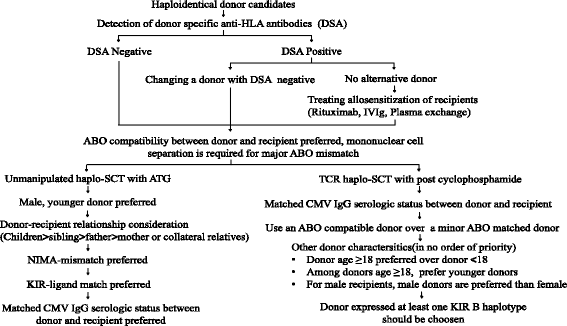How do we choose the best donor for T-cell-replete, HLA-haploidentical transplantation?
- PMID: 27071449
- PMCID: PMC4830035
- DOI: 10.1186/s13045-016-0265-2
How do we choose the best donor for T-cell-replete, HLA-haploidentical transplantation?
Abstract
In haploidentical stem cell transplantations (haplo-SCT), nearly all patients have more than one donor. A key issue in the haplo-SCT setting is the search for the best donor, because donor selection can significantly impact the incidences of acute and chronic graft-versus-host disease, transplant-related mortality, and relapse, in addition to overall survival. In this review, we focused on factors associated with transplant outcomes following unmanipulated haplo-SCT with anti-thymocyte globulin (ATG) or after T-cell-replete haplo-SCT with post-transplantation cyclophosphamide (PT/Cy). We summarized the effects of the primary factors, including donor-specific antibodies against human leukocyte antigens (HLA); donor age and gender; killer immunoglobulin-like receptor-ligand mismatches; and non-inherited maternal antigen mismatches. We also offered some expert recommendations and proposed an algorithm for selecting donors for unmanipulated haplo-SCT with ATG and for T-cell-replete haplo-SCT with PT/Cy.
Keywords: Age; Donor; Donor-specific anti-human leukocyte antigen antibody; Natural killer alloreactivity; Non-inherited maternal antigen mismatch; Unmanipulated haploidentical stem cell transplantation.
Figures

References
-
- Baron F, Labopin M, Ruggeri A, et al. Unrelated cord blood transplantation for adult patients with acute myeloid leukemia: higher incidence of acute graft-versus-host disease and lower survival in male patients transplanted with female unrelated cord blood—a report from Eurocord, the Acute Leukemia Working Party, and the Cord Blood Committee of the Cellular Therapy and Immunobiology Working Party of the European Group for Blood and Marrow Transplantation. J Hematol Oncol. 2015;8(1):107. doi: 10.1186/s13045-015-0207-4. - DOI - PMC - PubMed
-
- Baron F, Zachee P, Maertens J, et al. Non-myeloablative allogeneic hematopoietic cell transplantation following fludarabine plus 2 Gy TBI or ATG plus 8 Gy TLI: a phase II randomized study from the Belgian Hematological Society. J Hematol Oncol. 2015;8:4. doi: 10.1186/s13045-014-0098-9. - DOI - PMC - PubMed
Publication types
MeSH terms
Substances
Grants and funding
LinkOut - more resources
Full Text Sources
Other Literature Sources
Medical
Research Materials

